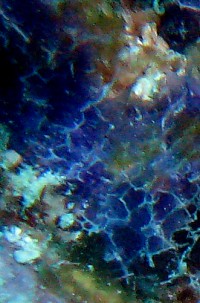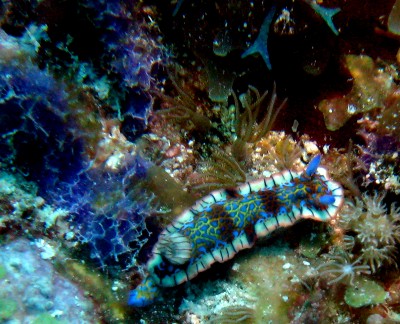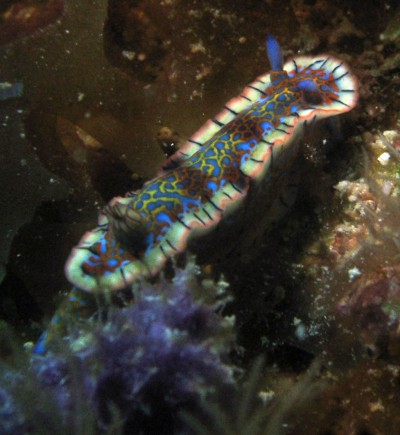Re: Hypselodoris acriba or H. bayeri?
August 31, 2009
From: Wayne Atkinson

Concerning message #16899:
Dear Bill,
Further to Valda Bromfield's and Eveline Marcus' photos of Hypselodoris bayeri from the Virgin Islands I attach a couple of shots of the same animal, again from the Virgin islands. It seems this colour morph (if that is what it is) with the lines around the mantle is the norm here - I hope these are useful/of interest.
Locality: Mercurious Rock, 12 metres, Jost Van Dyke, BVI, Caribbean Sea, 28 August 2009, rock reef. Length: 2 inches. Photographer: Wayne Atkinson.
Wayne Atkinson
wl.atkinson@gmail.com



Dear Wayne,
More photos of these puzzling caribbean chromodorids are always welcome. Although photos alone will not resolve the puzzles, I have found them extremely valuable in the past when you are trying to formulate the question to ask. For example can the animals I am calling H. acriba and H. bayeri on the Forum be just colour forms of one species. And is the animal in Lureen Ferretti's recent message [#22617] also a colour form? One problem is that some of the existing species were not well described, and another problem is that species of Hypselodoris and Chromodoris are well-known mimics, with groups of similarly coloured species evolving in the same geographic region. As I mentioned earlier, [message #7999], Eveline Marcus considered your animal to be a colour form of H. bayeri, while in Carribean Sea Slugs it is considered a possible form of H. acriba.
Your animal could well be associated with the bright blue sponge in your photos - which I suspect is a species of Dysidea. Interestingly this is the same sponge which is illustrated in Carribean Sea Slugs as the food of Hypselodoris sp. 3 - which I suspect is part of the H. bayeri complex. However most species of Hypselodoris feed on dysideid sponges so we can't make too much of them feeding on the same sponge.
Sorting out problems like this can't be done in an a chair 1000s of km away. I suspect what is needed is a local research worker who is able to study populations over a number of years, and record colour variability, study anatomy and biology and has the help of dedicated amateurs who can make extra collections and observations. Visiting researchers, no matter how skilled, can only collect small samples in place and time, and as we can see from the present situation, this can lead to confusion rather than clarification.
-
Valdes, A., Hamann, J., Behrens, D.W. & DuPont, A. 2006. Caribbean Sea Slugs. Sea Challengers.
Best wishes,
Bill Rudman
Related messages
-
Re: Hypselodoris bayeri in Curacao
From: Terence Zahner, January 18, 2010 -
Hypselodoris bayeri in Curacao
From: Terence Zahner, January 14, 2010 -
A new chromodorid from the Caribbean?
From: Lureen Ferretti, August 27, 2009 -
Hypselodoris bayeri from Bonaire
From: Pam McPherson, September 5, 2008 -
Re: Hypselodoris bayeri ? from Bonaire
From: Ellen Muller, July 18, 2008 -
Chromodorid from Bonaire
From: Per Lagerberg, October 17, 2007 -
Hypselodoris bayeri from Honduras
From: Florent Charpin, June 27, 2006 -
Hypselodoris acriba or H. bayeri?
From: Valda Bromfield, June 19, 2006 -
Hypselodoris sp. 5 from Honduras
From: Les Wilk, December 14, 2005 -
Colour variant of Hypselodoris sp. 5 from St Kitts
From: Kelly Griggs, February 4, 2005 -
Hypselodoris bayeri from Florida
From: Phillip Gillette, February 3, 2005 -
Re: Hypselodoris from Bonaire (Caribbean)
From: Ron Velarde, May 27, 2003 -
Hypselodoris bayeri? from Colombia
From: Néstor E. Ardila , February 23, 2003 -
Radula of Hypselodoris bayeri?
From: Néstor E. Ardila , February 23, 2003 -
Hypselodoris bayeri from Belize
From: Dave Behrens, September 27, 2002 -
Hypselodoris bayeri - Marcus photo
From: Bill Rudman, September 23, 2002
